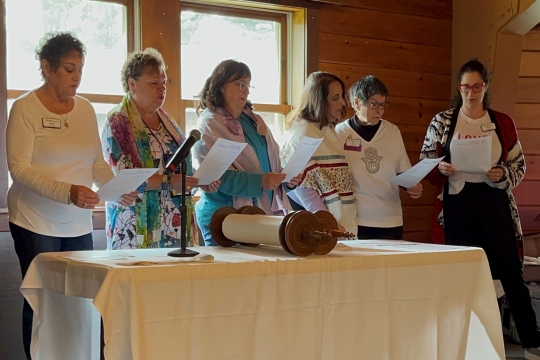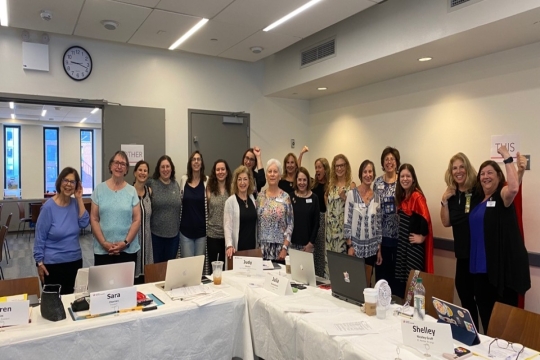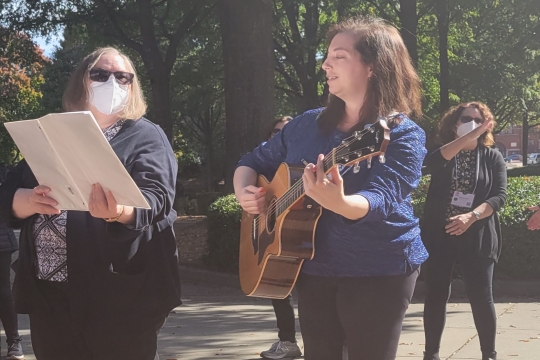The inspiration for my D’Var Torah is found in Exodus 14:19, but before explaining why, a brief summary of the whole of Parashat B’shalach is warranted for it is action-packed.
Parashat B’shalach begins and ends with the Israelites traveling, first as a funeral procession and second as a dancing group celebrating deliverance from oppression. Specifically, Parashat B’shalach tells of Moses’s adventures leading the Israelites out of Egypt and, instead of taking the direct costal route “by way of the land of the Philistines, although it was nearer” [Exodus 13:17] Moses takes a longer more circuitous route “round about, by way of the wilderness at the Sea of Reeds” [Exodus 13:18]. While moving in a zigzag forward and backward manner, the Israelites’ divine guide is seen in “a pillar of cloud by day, to guide them along the way, and in a pillar of fire by night to give them light …” [Exodus13:21].
Parashat B’shalach describes battles of sea and land. The first battle is with the King of Egypt who “ordered his chariot and took his force with him” [Exodus 14:6]
and the last battle is with Amalek at Rephidim. Noteworthy is that Moses controls battles first with nature and later with soldiers by lifting his arm and rod. This note of worth is found in the words of Exodus 14:16, “Lift up your rod and hold out your arm over the sea and split it, so that the Israelites may march into the sea on dry ground” and in the words of Exodus 17:11, “whenever Moses held up his hand, Israel prevailed; but whenever he held down his hand Amalek prevailed.”
One may wonder how the sojourners were at times a funeral procession and at other times a parade of celebration. The answers are found by comparing the words of Exodus 13:19, “And Moses took with him the bones of Joseph,” to the words of the “Song of the Sea” in Exodus 15:1-15:21, “Then Moses and the Israelites sang this song … Miriam sang to them: Sing to the Lord, for he is highly exalted.”
One may also wonder what else happens in Parashat B’shalach, and the answers are complaints and resolutions about lack of water and lack of food. For example, in Exodus 15:14, “the people grumbled against Moses and, saying ‘What shall we drink?’” and in Exodus 16:3 the people say “… you have brought us out into this wilderness to starve …” Luckily, for the Israelites, miracles happen and water is issued from a rock and bread rains from the sky as described in Exodus 17:6, “Strike the rock and water will issue from it” and Exodus 16:4, “I will rain down bread for you from the sky.” Truly, Parashat B’shalach is action-packed.
That said, why is it, among all the other events in Parashat B’shalach described above, that Exodus 14:19 stands out as an inspiration? It stands out because, in my interpretation, the clear description of leadership flexibility applies to my work with WRJ. In 14:19 after a new leader is identified, it is shown that by leading from behind, miracles can happen.
Exodus 14:19 describes how the leaders of a people facing the challenge of crossing the Sea of Reeds move from being in the front of a group to being in the rear of the group and, by so doing, facilitate a successful thrust forward. Exodus 14:19 specifically states that “The angel of God, who had been going ahead of the Israelite army, now moved and followed behind them; and the pillar of cloud shifted from in front of them and took up a place behind them.”
This description inspired my interpretation that as a member of WRJ’s North American Board of Directors whose term is coming to a close, hence, ending my work as my congregation’s WRJ representative, I may still support WRJ by standing behind those going forward and lending to them all the encouragement and protection needed.
Gabrielle Grunau has been a WRJ North American Board member since 2013 and, in January, will be installed on the Board of Directors of Little Falls Village, a member of the Village to Village Network in her Bethesda, Maryland area. Gabrielle is an active volunteer at Washington Hebrew Congregation where she and her three grown children have been members for 33 years. Gabrielle worked professionally as an organizational psychologist in educational settings with a specialty in workplace bullying.
Related Posts

Parashat Yom Rishon shel Rosh HaShanah

Cultivating a Culture of Accountability and Belonging

